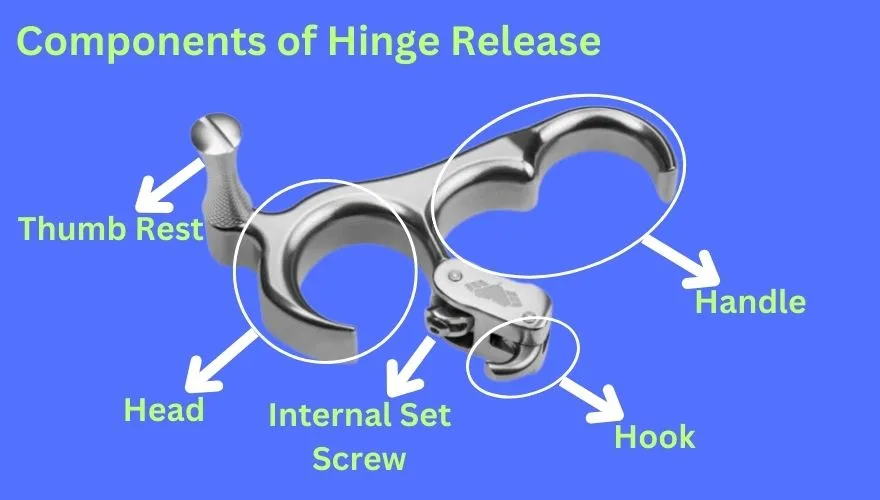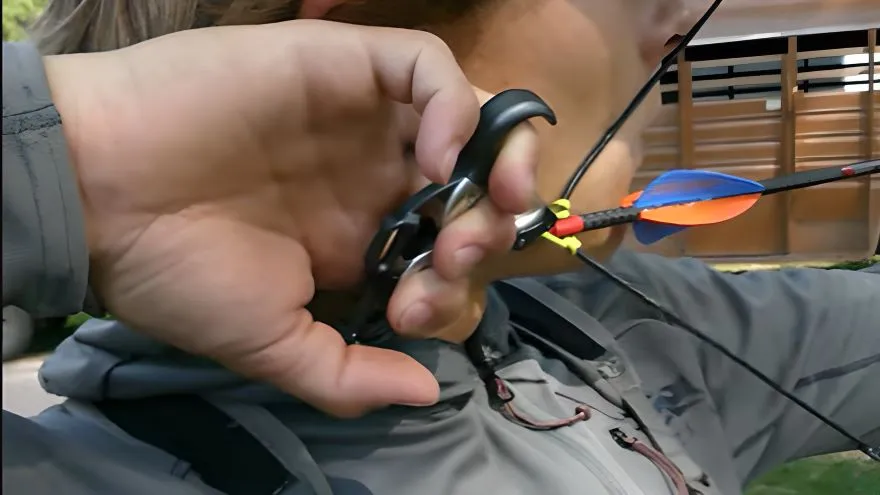If you are familiar with releases you might have heard about back tension or hinge releases, their core function is to help you achieve a clean release of arrow from the bowstring but with the help of your back muscles. Now you might be thinking, what is the difference between these both?
Don’t worry about the terms “back tension” and “hinge” – they’re essentially talking about the same thing. Some folks call it a back tension release because it’s all about using your back muscles to create that tension and release the arrow. Others use the term “hinge” because the mechanism has a hinge-like movement. So, whether you hear one or the other, they’re talking about this particular kind of release that relies on controlled tension and movement to shoot.
What Is a Back Tension Release?
A back tension release, also known as a hinge release, is an archery tool that employs controlled muscle tension and rotational mechanics. It’s activated when an archer, while drawing the bowstring, reaches a specific point where muscle tension naturally releases, enabling a smooth arrow release.
Most archery releases involve using your finger to pull a trigger, which can lead to jerky and inconsistent shots. With a back tension release, you’re not pulling a trigger directly. Instead, you use your muscles to build up tension while aiming, and the release happens when the tension becomes strong enough. This technique enhances shooting accuracy by minimizing abrupt movements associated with traditional trigger releases.
How Does a Back Tension Release Work?
A hinge release consists of three key components: the handle, the head, and the hook. Each of these parts contributes to how the release works. Here’s a breakdown of what each component does:
1. Handle
The handle is the part meant to be held. It functions as a grip. It’s important to hold it gently, without gripping it too tightly.
2. Head
The head is where the action originates. It’s akin to the starting point of a process. It takes the tension from the archer and undergoes a slight rotation.
3. Hook

The hook is responsible for connecting to the bowstring. Its role is to release the bowstring in a smooth manner when the archer is prepared to shoot.
Now, let’s break down how these parts collaborate to make the hinge release function. The archer holds the head using their index finger and grasping the handle with their remaining fingers. The thumb is typically positioned on a thumb release.
The head and handle are connected with a pin that allows rotation of the head. On the other hand, the hook securely holds onto the string of the bow.
As the archer draws the bowstring back and reaches the anchor point, the engagement of their back muscles becomes significant. At this point, the tension is on the three fingers holding the handle and head, and the thumb and pinky finger are relaxed. By keeping the focus on the back muscles the archer gradually relaxes their hand, the grip on the tool’s handle loosens, and the index finger naturally initiates a slight rotation of the head.
This rotation prompts the release mechanism, resulting in the arrow being released for its flight.
I hope you get the idea of how it works, If it is not yet clear to you, we have discussed it in the “How to shoot with hinge release” article and also discussed the two methods to initiate the release mechanism.
Why Do You Need a Back Tension Release?
When it comes to archery, consistency is key. A back tension release is your partner in precision. It helps eliminate jerky movements that can throw off your shot. By using this tool, you build a smoother, more accurate shooting style over time.
Benefits of a Back Tension Release
1. Controlled Shots: Hinge releases promote controlled shooting, minimizing abrupt triggers and resulting in steadier shots.
2. Improved Accuracy: With consistent practice, hinge releases lead to heightened shooting accuracy and enhanced overall performance.
3. Reduced Target Panic: The gradual nature of hinge releases can help alleviate target panic, contributing to a calmer shooting experience.
4. Muscle Memory: Regular use of hinge releases helps develop muscle memory, ensuring a more consistent and reliable shooting technique.
Disadvantages Of a Hinge Release
1. Premature Firing: Inexperienced users may encounter early arrow releases due to improper muscle engagement or release timing.
2. Click Setting Challenges: Adjusting the release’s click setting can be tricky, impacting shot consistency and requiring precise tuning.
3. Back Tension Release for Hunting: While effective for target shooting, transitioning hinge releases to hunting scenarios demands careful adaptation and practice. A thumb release is preferred for hunting.
How to Choose A Hinge Or Back Tension Release
Choosing the right hinge release is a bit like selecting the perfect tool for a task. Let’s explore the options a bit more:

1. Click vs. No Click
Some hinge releases have a little sound, like a “click,” right before they work. It’s a signal that tells you the release is ready. Other releases don’t make a sound. It’s like having a sign that your shot is all set and ready to go.
2. Wrist Strap vs. Handheld
You can pick between two types of releases. One type straps onto your wrist, a bit like wearing a watch. This adds stability to your shot, just like an anchor holds a boat steady. The other type is held in your hand, giving you a bit more freedom to move. It’s like choosing between a stable anchor and more flexibility.
3. Back Tension Release Having Safety
Imagine having an extra layer of control. Some hinge releases come with a safety feature. This means the release only works when you want it to. It’s like having a safety switch that prevents accidental shots. When you start to draw, you hold the safety so the bow won’t fire unless you don’t take your hand off safety. When you are ready to aim or shoot take your hand off the safety and start shooting.
4. Multiple Finger Styles
Certain hinge releases offer different finger options. You can find ones that work well with three fingers or even four fingers, giving you more comfort and control based on your preference.
5. Resistance Adjustment
Some hinge releases allow you to adjust how much force is needed to activate the release. This customization can help you find the perfect balance between control and ease of use.
Ultimately, the best hinge release for you depends on what feels right and boosts your confidence. It’s like finding the perfect tool in your toolbox – the one that fits perfectly and helps you do your best work.
How to Shoot A Hinge Release
Now it’s time to shoot the thumb release, let’s have an overview of the two methods to shoot a thumb release.

1. Backtension Method
The back tension method is a popular technique for using a thumb release in archery. It focuses on creating a smooth and surprising release by using your back muscles rather than your thumb or fingers.
Mechanism: In this method, the archer uses back tension to activate the release. The thumb or finger merely rests on the release trigger without applying direct pressure.
Execution: The archer draws the bowstring, and anchors, and then activates the release by expanding their back muscles. This creates a controlled and surprise release, enhancing accuracy.
Benefits: The backtension method helps eliminate target panic and flinching, resulting in more consistent and accurate shots.
2. Finger Rotation Method:
The finger rotation method, also known as the hinge method, involves using the finger to apply pressure and control the release of the bowstring.
Mechanism: In this method, the archer relies on finger movement to control the release. The release has a hinge-like mechanism that rotates when pressure is applied.
Execution: The archer draws the bowstring, and anchors, and gradually rotates the release using their index finger by shifting the tension to the middle and other fingers. The rotation of the release causes it to open and release the bowstring.
Benefits: The finger rotation method provides precise control over the release, allowing archers to maintain consistent shot execution. It’s a technique often favored by those who prefer a tactile feel in their shot process.
If you want to learn more about shooting a hinge release, including detailed instructions and tips, check out our article on how to shoot a hinge release. This comprehensive guide will provide you with step-by-step instructions to master this shooting technique.
Conclusion
A back tension or hinge release is a popular release among archers. Most people prefer releases that are activated with back tension so their arrow is released from the bowstring in a much more controlled and natural fashion. This minimizes the risk of jerking the shot and reduces target panic. The hinge release is an excellent choice for professionals. For beginners, I would recommend the finger trigger release or the thumb release. Explore more options in the release and find one that suits your style.
